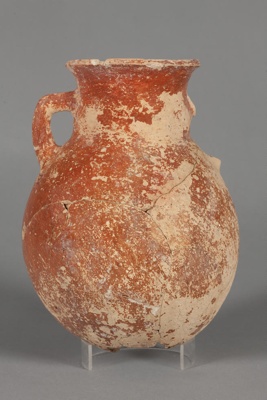< Collection search
< Collection highlights
From:UC Teece Museum of Classical Antiquities
Name/TitleAmphora
About this objectFound in a pit-tomb near Nicosia in Cyprus, this Bronze Age amphora made for storing foodstuffs is a round-bottomed vase with a wide neck and out-turned mouth. The remaining handle is almost rectangular in shape and curves from the mid-neck to high on the body.
Made of pale brown clay, the vase has been covered in a dull brownish red slip which extends into the inside of the mouth and neck. There is no wash inside the belly of the amphora. There are many voids showing on the worn surface, caused by degradation of inclusions used to hold the clay together.
Round bottomed vessels were common in this region during the Bronze Age. It is thought that they were kept upright by making shallow depressions in the ground, and smaller bowls could be hung away when not in use. One reason potters made rounded shapes was because they were less likely to crack in a kiln than objects with sharp corners.
Date Made21st Century BC
PeriodEarly Cypriote
Place MadeCyprus
Place NotesExcavated from Ayia Paraskevi, tomb 11
Medium and MaterialsCeramic: Pottery
Style and IconographyCypriote
Style and IconographyRed polished III
TechniqueMolding (forming)
TechniqueModeling (forming)
MeasurementsHeight ca. 223mm (preserved); Diameter 168mm
Subject and Association KeywordsMourning customs
Subject and Association KeywordsFood history
Named CollectionThe James Logie Memorial Collection, University of Canterbury, New Zealand
Credit LineDonated by the Melbourne University Cyprus Expedition, care of Dr J.B. Hennessy, University of Sydney,1973.
Object TypeStorage Vessels
Object number123.73
Copyright LicenceAll rights reserved
